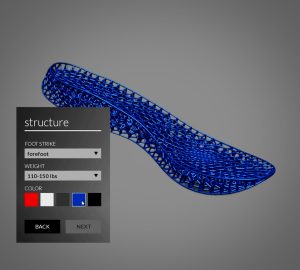New Balance and Formlabs Launch TripleCell 3D Printing Platform and Rebound Resin for Athletic Shoes
While I’m not much for recreational jogging these days, I’ll always remember my first real running shoes – a pair of dark gray Sauconys, which I got to pick out from the store when I made the track team in seventh grade; a short-lived activity, as I was neither fast enough for sprinting nor strong enough for shot put. Shoes have changed dramatically since then in their looks and features. Manufacturing processes have only recently begun to change with new weaving techniques, more use of polymers, and 3D printing. With the way things are going these days, it may not be long before everyone’s favorite pair of athletic shoes is of the 3D printed variety, no matter which manufacturer they come from.
Back in 2015, Boston-based athletic leader New Balance announced that it was teaming up with 3D Systems to create the first 3D printed running shoe. The company released its Zante Generate shoe a year later, and while it wasn’t the first 3D printed shoe ever created, it was the first to be made commercially available.
 Now, New Balance has launched a brand new premium 3D printing platform, called TripleCell, which is powered by SLA technology from Formlabs and a completely new material.
Now, New Balance has launched a brand new premium 3D printing platform, called TripleCell, which is powered by SLA technology from Formlabs and a completely new material.
“3D printing is changing how companies approach manufacturing, with this announcement New Balance is pioneering localized manufacturing. By eliminating the dependence on molds and direct printing for both prototyping and production, their team shifts from months to hours in the development and production cycles,” said Dávid Lakatos, Chief Product Officer of Formlabs. “We’re moving towards a world where design cycles are closing in on the whim of the consumer and it’s exciting to be on the frontlines of this with New Balance.”
 It all started last year, when the two Massachusetts companies announced an exclusive relationship focused on creating high performance hardware and materials, in addition to a manufacturing process for athletic footwear. They wanted to create a 3D printing production system, with unlimited design freedom, that would open up opportunities for innovation in the athletic footwear sector – a high inventory, high volume business that involves plenty of craftsmanship and manual labor. But as more people clamor for customized products, it’s getting harder to produce them without embracing modern technology.
It all started last year, when the two Massachusetts companies announced an exclusive relationship focused on creating high performance hardware and materials, in addition to a manufacturing process for athletic footwear. They wanted to create a 3D printing production system, with unlimited design freedom, that would open up opportunities for innovation in the athletic footwear sector – a high inventory, high volume business that involves plenty of craftsmanship and manual labor. But as more people clamor for customized products, it’s getting harder to produce them without embracing modern technology.
Katherine Petrecca, New Balance General Manager of Footwear, Innovation Design Studio, said in a Formlabs blog post, “We saw innovation with 3D printers and materials and started to envision the future of how this could come together in consumer products.
“When you’re able to use techniques like 3D printing to turn to more of an on-demand manufacturing model, that’s a game changer. There are advantages both for the consumer and for New Balance as a manufacturer. On the consumer side, the ability to design and what you can fabricate with printing is well beyond what we can do with molding. It really opens up a lot of opportunity for us to make better parts than we’re making now with foam and plastic.”
New Balance realized it would need a specific material that didn’t yet exist in the industry. The new TripleCell platform can deliver components that are pretty close to traditional performance cushioning, thanks to the proprietary photopolymer Rebound Resin that was developed as a result of the partnership. Rebound Resin was designed in order to make resilient, springy lattice structures with, according to a Formlabs press release, “the durability, reliability, and longevity expected from an injection molded thermoplastic.”
“TripleCell will deliver the industry’s pinnacle expression of data to design with seamless transitions between variable properties underfoot. This new, cutting edge, digitally manufactured technology is now scaling exclusively within New Balance factories in the U.S. further establishing us as a leader in 3D printing and domestic manufacturing,” said Petrecca. “Formlabs has been an integral partner to bring this to life. We’re really going to be able to disrupt the industry not only in performance, but also in athlete customization and speed to market.”
 Rebound Resin has a higher tear strength, energy return, and elongation than any other Formlabs SLA material. Most foam components in current footwear are made with compression or injection molding, which limits design possibilities. But using 3D printing for prototyping and production has allowed New Balance to open brand new opportunities in the fabrication of its footwear.
Rebound Resin has a higher tear strength, energy return, and elongation than any other Formlabs SLA material. Most foam components in current footwear are made with compression or injection molding, which limits design possibilities. But using 3D printing for prototyping and production has allowed New Balance to open brand new opportunities in the fabrication of its footwear.
“What we could do to date is engineer the outside of the shoe and rely on the inherent properties of the material to provide all the performance benefits we’re looking for,” explained New Balance Senior Additive Manufacturing Engineer Dan Dempsey. “Any degree of what you could consider customization is disparate pieces of foam glued or molded together, with a lot of assembly steps on the back end. Using additive manufacturing, we can essentially vary the lattice structure to really change localized properties inside of a single form, giving us the ability to engineer throughout the entire volume of the shoe; we can design a system from the inside out.”
Using the new TripleCell platform for both prototyping and manufacturing allows the creation of shoes with a high cushion zone, which transitions to an area of high stability, within a single design, using a single material. It also helps decrease the time to market.
“The traditional timeline for our product cycle from paper initiation to delivery in market is 15-18 months. And when we’re building tools and waiting for foam or rubber parts, we’re looking at 4-6 week lead times. By eliminating molds, we can save months of development time,” said Petrecca. “TripleCell technology makes it possible to easily produce multiple designs at the same time, reinventing the traditional iterative testing approach. We had the ability to generate and edit thousands of options before landing on the high-performance, running focused structures you see today.”
 This week, New Balance launched the first product from its new platform – the limited edition $185 990 Sport, which is now shipping and features TripleCell technology in the heel for a cushioning experience on par with its classic silhouette, but is 10% more lightweight than the 990v5 shoe.
This week, New Balance launched the first product from its new platform – the limited edition $185 990 Sport, which is now shipping and features TripleCell technology in the heel for a cushioning experience on par with its classic silhouette, but is 10% more lightweight than the 990v5 shoe.
The $175 FuelCell Echo shoe will come in September, and the first full-length high performance running product will launch in 2020.
Petrecca said, “The TripleCell 3D printed components deliver more lively, spring-like cushioning than you’ve ever experienced in foam, with the ability to ultimately be produced on-demand in our own facilities in Massachusetts.”
Discuss this story and other 3D printing topics at 3DPrintBoard.com or share your thoughts below.
[Source/Images: Formlabs]Subscribe to Our Email Newsletter
Stay up-to-date on all the latest news from the 3D printing industry and receive information and offers from third party vendors.
You May Also Like
Gorilla Sports GE’s First 3D Printed Titanium Cast
How do you help a gorilla with a broken arm? Sounds like the start of a bad joke a zookeeper might tell, but it’s an actual dilemma recently faced by...
Nylon 3D Printed Parts Made More Functional with Coatings & Colors
Parts 3D printed from polyamide (PA, Nylon) 12 using powder bed fusion (PBF) are a mainstay in the additive manufacturing (AM) industry. While post-finishing processes have improved the porosity of...
$25M to Back Sintavia’s Largest Expansion of Metal 3D Printing Capacity Since 2019
Sintavia, the digital manufacturing company specializing in mission-critical parts for strategic sectors, announced a $25 million investment to increase its production capacity, the largest expansion to its operations since 2019....
Velo3D Initiates Public Offering in a Bid to Strengthen Financial Foundations and Drive Future Growth
Velo3D (NYSE: VLD) has been among a number of publicly traded 3D printing firms that have attempted to weather the current macroeconomic climate. After posting a challenging financial report for 2023,...


































